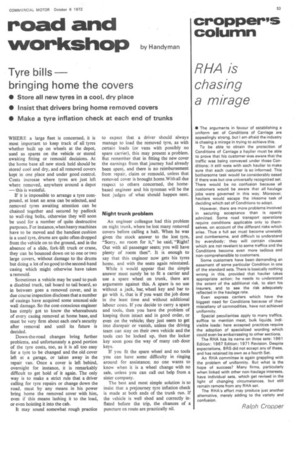road and workshop
Page 55

If you've noticed an error in this article please click here to report it so we can fix it.
by Handyman
Tyre bills bringing home the covers
• Store all new tyres in a cool, dry place • Insist that drivers bring home removed covers • Make a tyre inflation check at each end of trunks
WHERE a large fleet is concerned, it is most important to keep track of all tyres whether built up on wheels at the depot, used as spares on the vehicle or stored awaiting fitting or remould decisions. At the home base all new stock held should be stored cool and dry, and all removed covers kept in one place and under good control. Costs increase where tyres are just left where removed, anywhere around a depot — this is wasteful.
If it is impossible to arrange a tyre compound, at least an area can be selected, and removed tyres awaiting attention can be chained together and secured by padlock to wall-ring bolts, otherwise they will soon be used for a number of quite destructive purposes. For instance, when heavy machines have to be moved and the handiest cushion is a used tyre, drums are quite often dropped from the vehicle on to the ground, and in the absence of a slide, fork-lift truck or crane, they can be bounced down on to one or two large covers, without damage to the drums but doing a lot of no good to the second-hand casing which might otherwise have taken a remould.
Sometimes a vehicle may be used to push a disabled truck, tail board to tail board, so in between goes a removed cover, and in due course inspection discloses that a number of casings have acquired some unusual side wall damage. So the cost-conscious engineer has simply got to know the whereabouts of every casing removed at home base, and must be very firm about each one's security after removal and until its future is decided.
Down-the-road changes bring further problems, and unfortunately a good portion of the tyre costs, too, as it is all too easy for a tyre to be changed and the old cover left at a garage, or taken away in the repair van. Once a cover is left behind, overnight for instance, it is remarkably difficult to get hold of it again. The only way is to make a strict rule that a driver calling for tyre repairs or change down the road, must by any means in his power bring home the removed cover with him, even if this means lashing it to the load, or even hoisting it into the cab.
It may sound somewhat rough practice to expect that a driver should always manage to load the removed tyre, as with certain loads (or vans with possibly no spare carrier), this may present a problem. But remember that in fitting the new cover the earnings from that journey had already been spent, and there is no reimbursement from repair, claim or remould, unless that removed cover is brought home.With all due respect to others concerned, the homebased engineer and his tyreman will be the best judges of what should happen next.
Night trunk problem An engineer colleague had this problem on night trunk, where he lost many removed covers before calling a halt. When he was given the stock answer to the lost tyre, "Sorry, no room for it," he said; "Right! Out with all passenger seats; you will have plenty of room then". It is enough to say that this engineer now gets his tyres home, and with the seats again reinstated.
While it would appear that the simple answer must surely be to fit a carrier and use a spare wheel on trunk, there are arguments against this. A spare is no use without a jack, bar, wheel key and bar to go with it, that is if you want the job done in the least time and without additional labour costs. If you decide to carry a spare and tools, then you have the problem of keeping them intact and in good order, or even on the vehicle; they just seem to get into disrepair or vanish, unless the driving team can stay on their own vehicle and the tools can be locked up, then the locker key soon goes the way of many cab door keys.
If you fit the spare wheel and no tools you can have some difficulty in ringing around for assistance; no one wants to know when it is a wheel change with no sale, unless you can call out help from a sister company.
The best and most simple solution is to insist that a prejourney tyre inflation check is made at both ends of the trunk run. If the vehicle is well shod and correctly inflated before the trip, the chances of a puncture en route are practically nil.






































































































